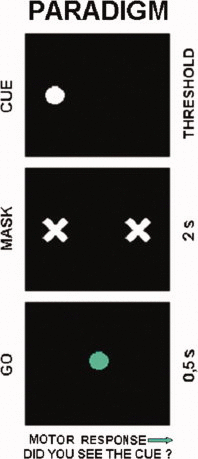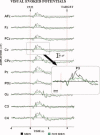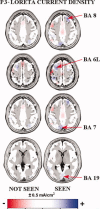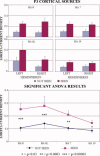Cortical sources of visual evoked potentials during consciousness of executive processes
- PMID: 18465752
- PMCID: PMC6870819
- DOI: 10.1002/hbm.20567
Cortical sources of visual evoked potentials during consciousness of executive processes
Abstract
What is the timing of cortical activation related to consciousness of visuo-spatial executive functions? Electroencephalographic data (128 channels) were recorded in 13 adults. Cue stimulus briefly appeared on right or left (equal probability) monitor side for a period, inducing about 50% of recognitions. It was then masked and followed (2 s) by a central visual go stimulus. Left (right) mouse button had to be clicked after right (left) cue stimulus. This "inverted" response indexed executive processes. Afterward, subjects said "seen" if they had detected the cue stimulus or "not seen" when it was missed. Sources of event-related potentials (ERPs) were estimated by LORETA software. The inverted responses were about 95% in seen trials and about 60% in not seen trials. Cue stimulus evoked frontal-parietooccipital potentials, having the same peak latencies in the seen and not seen data. Maximal difference in amplitude of the seen and not seen ERPs was detected at about +300-ms post-stimulus (P3). P3 sources were higher in amplitude in the seen than not seen trials in dorsolateral prefrontal, premotor and parietooccipital areas. This was true in dorsolateral prefrontal and premotor cortex even when percentage of the inverted responses and reaction time were paired in the seen and not seen trials. These results suggest that, in normal subjects, the primary consciousness enhances the efficacy of visuo-spatial executive processes and is sub-served by a late (100- to 400-ms post-stimulus) enhancement of the neural synchronization in frontal areas.
Figures







References
-
- Babiloni F,Babiloni C,Fattorini L,Carducci F,Onorati P,Urbano A ( 1995): Performances of surface Laplacian estimators: A study of simulated and real scalp potential distributions. Brain Topogr Fall 8: 35–45. - PubMed
-
- Babiloni C,Bares M,Vecchio F,Brazdil M,Jurak P,Moretti DV,Ubaldi A,Rossini PM,Rektor I ( 2004): Synchronization of gamma oscillations increases functional connectivity of human hippocampus and inferior‐middle temporal cortex during repetitive visuomotor events. Eur J Neurosci 19: 3088–3098. - PubMed
-
- Babiloni C,Vecchio F,Bultrini A,Romani GL,Rossini PM ( 2005): Pre‐ and poststimulus alpha rhythms are related to conscious visual perception: A high‐resolution EEG study. Cereb Cortex 16: 1690–1700. - PubMed
-
- Babiloni C,Vecchio F,Miriello M,Romani GL,Rossini PM ( 2006a): Visuo‐spatial consciousness and parieto‐occipital areas: A high‐resolution EEG study. Cereb Cortex 16: 37–46. - PubMed
-
- Babiloni C,Vecchio F,Rossi S,De Capua A,Bartalini S,Ulivelli M,Rossini PM ( 2006b): Human ventral parietal cortex plays a functional role on visuospatial attention and primary consciousness. A repetitive transcranial magnetic stimulation study. Cereb Cortex 17: 1486–1492. - PubMed
Publication types
MeSH terms
LinkOut - more resources
Full Text Sources

